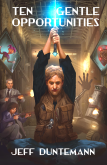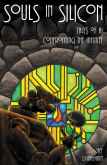Egad. Contra turned 20 when I wasn’t looking. Actually, I was looking. What I wasn’t doing was breathing. Enough. At night. I think I have a handle on that problerm now, and with any luck at all I’ll be writing more of everything going forward. I’m 50,000 words into my new novel Dreamhealer, and tinkering the last bits of my free ebook FreePascal From Square One. There’s much to be done, now that my energy is starting to come back.
The anniversary was this past June 5. On June 5, 1998, the very first entry in Jeff Duntemann’s VDM Diary went up on the Coriolis Web server. That first entry was nothing grandiose. I didn’t have permalinks on those early entries, so I’ll quote it here in its entirety:
Spent most of this past week in Chicago at Book Expo America, and saw two remarkable “book on demand” operations of interest to small software developers. Both IBM and Xerox have developed super hi-res, high-speed laser printers that print on continuous roll paper, almost like miniature offset printing presses. Both firms have set up subsidiaries to act as service bureaus, capable of producing high-quality perfect-bound books with glossy four-color covers, quantity one, at a unit price of between $2 and $4, depending on the size of the book. They’re targeting the service at small press, and to keep low-volume books from going out of print entirely. But you and I know the real application here is going to be software documentation for small developers, especially shareware developers whose volumes are smallish and unpredictable. Go take a look: IBM and Ingram’s partnership LightningPrint is at www.lightningprint.com.
Those early entries didn’t have titles, and were not the long-form essays that evolved over time, but instead short, newsy items much like I later came to publish as Odd Lots.
For those who didn’t know me back then, “VDM” was our (carefully chosen) acronym for Visual Developer Magazine, published by The Coriolis Group from 1990-2000. By 2000 most of our energy went into books. The magazine, in competition with increasingly sophisticated (and free) Web pages, ceased to be viable toward the end of 1999. The March/April 2000 issue was the last, and VDM Diary closed down with Visual Developer itself.
By that time, however, I was hooked. On July 25, 2000, I created Contrapositive Diary on my own Web hosting space, where it’s been ever since.
So let’s go back to Contra’s secret origins. Without realizing it (and years before that truly ugly word came to prominence) I had invented blogging. Now, others invented it as well. There is such a thing as independent invention, and in truth the idea seems kind of obvious to me. I’m not sure Slashdot is a blog (I’ve always considered it a news site) but it launched in the fall of 1997, though I don’t remember seeing it until a couple of years later. Justin Hall is almost certainly the first blogger in the sense that we use the word today, having invented the concept back in 1994. Still further back in time, I remember reading a periodic (weekly?) posting on Usenet from Moonwatcher, a chap who posted about the phases of the Moon, eclipses, meteor showers, visible planets, and other things relating to astronomy. This was in 1981 or thereabouts, when I worked at Xerox and had a login to ARPANet. So yeah, it’s an old idea, and an obvious one.
Still, I think of it as the best idea I never had.
Huh? It’s true: Contra was someone else’s idea. My ad sales rep for VDM was Lisa Marie Hafeli, and in the spring of 1998 she approached me with a request: Find a way to publish something short online every day, or close to it. What she wanted was more product mentions, which helped her sell ads to industry firms. I wasn’t entirely sure that such a thing would work as an ad sales tool, but the notion of a daily diary online intrigued me. It took until June to get to the top of my stack. At the time I wasn’t in direct control of our Web presence, so (almost) every day before I went home from work I emailed the text to my webmaster Dave, and he added it to the tail end of the HTML file stored on our Web server.
I didn’t post every day, and not every post was a product mention, but the vehicle proved popular with our readers. I wasn’t surprised over the next couple of years when others did the same thing. As I said, it’s a pretty obvious idea. What did surprise me was the scope of its adoption. By the time the company itself shut down in the spring of 2002, the word “blog” had been coined, and blogs were all over the place.
I edited the HTML files by hand as the sole format until 2005, when I created an account on LiveJournal and used it as a mirror of the manually edited month files. I never really liked LiveJournal as a platform, but it did the job until I installed WordPress on my own hosting space in late 2008, launching on 1/1/2009. I later backported the 2008 month files to WordPress, found it more trouble than it was worth, and stopped there. My LiveJournal account still exists, but I get almost no comments on it and assume the platform is no longer as well-used as it was ten years or so ago.
I don’t post on Contra as often as I used to. I get a lot more traffic and exposure on Twitter and Facebook, and I periodically gather short items originally published on Twitter into Odd Lots. (I invariably add a few bullets that never went to Twitter for various reasons, so you won’t see all my Odd Lots on Twitter.)
That’s the story. I enjoy social networking a lot less than I used to, because so much of what goes around online is flat-out political hatred. Still, it’s one of the few ways to get above the noise and be heard. I’m trying to earn a reputation for not being crazy, but alas, the crazy stuff seems to get the most mileage these days. There are insights in that fact somewhere (a lot of insights, for what it’s worth) but I’m not entirely sure I want to be the one to describe them. I’d prefer a peaceful retirement, whatever it takes. Mostly what it takes is not talking about politics.
That’s been my policy for a long time, with only very occasional lapses. It will be my policy going forward, for as long as I can write at all.











